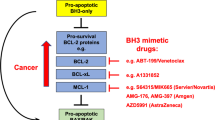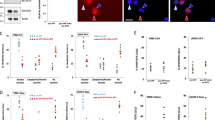Abstract
SCC-S2/GG2-1/NDED is a recently discovered antiapoptotic molecule induced by the activation of the transcription factor NF-κB. Here we have examined a role of SCC-S2 in cell growth regulation in vitro and in vivo. Western blotting using an antipeptide antibody revealed endogenous SCC-S2 as a ∼21 kDa cytosolic protein in human breast cancer cells (MDA-MB 231) and renal carcinoma cells (RCC-RS). The immunofluorescence detection method showed the cytosolic localization of FLAG-tagged human SCC-S2 in COS-1 transfectants. MDA-MB 435 human cancer cells stably transfected with the FLAG-tagged SCC-S2 cDNA exhibited increased growth rate as compared to control vector transfectants, as measured by the cell viability (>twofold; n=3; P<0.005) and thymidine-labeling procedures (∼sixfold; n=3; P<0.0001). SCC-S2 transfectants also displayed an increase in cell migration in collagen I as compared to control transfectants (∼twofold; n=3; P<0.005). In athymic mice, SCC-S2 transfectants showed significantly enhanced tumor growth as compared to control transfectants (mean tumor volumes, day 16: control, 56.86±19.82 mm3; SCC-S2, 127.54±18.78 mm3; n=5; P<0.03). The examination of a limited number of clinical specimens revealed higher expression levels of SCC-S2 protein in certain human tumor tissues as compared to the matched normal adjacent tissues. Taken together, the present studies demonstrate SCC-S2 as a novel oncogenic factor in cancer cells.
This is a preview of subscription content, access via your institution
Access options
Subscribe to this journal
Receive 50 print issues and online access
$259.00 per year
only $5.18 per issue
Buy this article
- Purchase on Springer Link
- Instant access to full article PDF
Prices may be subject to local taxes which are calculated during checkout




Similar content being viewed by others
References
Adelsman MA, McCarthy JB and Shimizu Y . (1999). Mol. Biol. Cell, 10, 2861–2878.
Bargou RCF, Emmerich F, Krapmann D, Bommert K, Mapara MY, Arnold W, Royer D, Grienstein E, Griener A, Scheidereit C and Dorken B . (1997). J. Clin. Invest., 100, 2961–2969.
Darnell Jr JE . (2002). Nat. Rev. Cancer, 2, 740–749.
Djerbi M, Screpanti V, Catrina AI, Bogen B, Biberfeld P and Grandien A . (1999). J. Exp. Med., 90, 1025–1032.
Eberstadt M, Huang B, Chen Z, Meadows RP, Ng S-C, Zheng L, Lenardo MJ and Fesik SW . (1998). Nature, 392, 941–945.
Hackam AS, Yassa AS, Singaraja R, Metzler M, Gutekunst C-A, Gan L, Warby S, Wellington CL, Vaillancourt J, Chen N, Gervais FG, Raymond L, Nicholson DW and Hayden MR . (2000). J. Biol. Chem., 275, 41299–41308.
Hinz M, Krappmann D, Eichten A, Heder A, Scheidereit C and Strauss M . (1999). Mol. Cell. Biol., 19, 2690–2698.
Hinz M, Lemke P, Anagnostopoulos I, Hacker C, Krappmann D, Mathas S, Dorken B, Zenke M, Stein H and Scheidereit C . (2002). J. Exp. Med., 196, 605–617.
Horrevoets AJ, Fontijn RD, van Zonneveld AJ, de Vries CJ, ten Cate JW and Pannekoek H . (1999). Blood, 93, 3418–3431.
Irmler M, Thome M, Hahne M, Schneider P, Hofmann K, Steiner V, Bodmer JL, Schroter M, Burns K, Mattmann C, Rimoldi D, French LE and Tschopp J . (1997). Nature, 388, 190–195.
Isaacs JS, Saito S and Neckers LM . (2001). J. Biol. Chem., 276, 18497–18506.
Kaufmann M, Bozic D, Briand C, Bodmer J-L, Zerbe O, Kohl A, Tschopp J and Grutter MG . (2002). FEBS Lett., 527, 250–254.
Keleg S, Buchler P, Ludwig R, Buchler MW and Friess H . (2003). Mol. Cancer, 2, 14–20.
Kumar D, Whiteside TL and Kasid U . (2000). J. Biol. Chem., 275, 2973–2978.
Kuwana T, Smith JJ, Muzio M, Dixit V, Newmeyer DD and Kornbluth S . (1998). J. Biol. Chem., 273, 16589–16594.
Leung SW, Mitchell JB, Al-Nabulsi I, Friedman N, Newsome J, Belldegrun A and Kasid U . (1993). Cancer, 71, 2276–2285.
Lim JW, Kim H and Kim KH . (2002). J. Biol. Chem., 277, 46093–46100.
Medema JP, de Jong J, van Hall T, Melief CJM and Offringa R . (1999). J. Exp. Med., 190, 1033–1038.
Micheau O, Lens S, Gaide O, Alevizopoulos K and Tschopp J . (2001). Mol. Cell. Biol., 21, 5299–5305.
Mori N, Fujii M, Ikeda S, Yamada Y, Tomonaga M, Ballard DW and Yamamoto N . (1999). Blood, 93, 2360–2368.
Mueller SC, Yeh Y and Chen WT . (1992). J. Cell Biol., 119, 1309–1325.
Nair A, Venkatraman M, Maliekal TT, Nair B and Karunagaran D . (2003). Oncogene, 22, 50–58.
Nakshatri H, Bhat-Nakshatri P, Martin DA, Goulet RJ and Sledge GW . (1997). Mol. Cell. Biol., 17, 3629–3639.
Orlowski RZ and Baldwin AS . (2002). Trends Mol. Med., 8, 385–389.
Owen-Schaub LB, van Golen KL, Hill LL and Price JE . (1998). J. Exp. Med., 188, 1717–1723.
Patel S, Wang F-H, Whiteside TL and Kasid U . (1997). Eur. J. Cancer Oral Oncol., 33, 197–203.
Ryu BK, Lee MG, Chi SG, Kim YW and Park JH . (2001). J. Pathol., 194, 15–19.
Scaife CL, Kuang J, Wills JC, Trowbridge DB, Gray P, Manning BM, Eichwald EJ, Daynes RA and Kuwada SK . (2002). Cancer Res., 62, 6870–6878.
Sovak MA, Bellas RE, Kim DW, Zanieski GJ, Rogers AE, Traish AM and Sonenshein GE . (1997). J. Clin. Invest., 100, 2952–2960.
Thome M and Tschopp J . (2001). Nat. Rev. Immunol., 1, 50–58.
Tibbetts MD, Zheng L and Lenardo MJ . (2003). Nat. Immunol., 4, 404–409.
Wajant H . (2002). Science, 296, 1635–1636.
Wang J, Lobito AA, Shen F, Hornung F, Winoto A and Lenardo MJ . (2000). Eur. J. Immunol., 30, 155–163.
Wang W, Abbruzzese JL, Evans DB and Chiao PJ . (1999a). Oncogene, 18, 4554–4563.
Wang W, Abbruzzese JL, Evans DB, Larry L, Cleary KR and Chiao PJ . (1999b). Clin. Cancer Res., 5, 119–127.
Xiao CW, Yan X, Li Y, Reddy SA and Tsang BK . (2003). Endocrinology, 144, 623–630.
Yeh WC, Itie A, Elia AJ, Ng M, Shu HB, Wakeham A, Mirtsos C, Suzuki N, Bonnard M, Goeddel DV and Mak TW . (2000). Immunity, 12, 633–642.
You Z, Ouyang H, Lopatin D, Polver PJ and Wang CY . (2001). J. Biol. Chem., 276, 26398–26404.
Zhang H, Xu Q, Krajewski S, Krajewska M, Xie Z, Fuess S, Kitada S, Pawlowski K, Godzik A and Reed JC . (2000). Proc. Natl. Acad. Sci. USA, 97, 2597–2602.
Acknowledgements
MDA-MB 231 and MDA-MB 435 human cancer cells were obtained from the Tissue Culture Shared Resource facility of the Lombardi Cancer Center, Georgetown University Medical Center. Mice studies were performed at the Research Resource Facility of the Division of Comparative Medicine, Georgetown University Medical Center. This study was supported by grants from the National Institutes of Health (P01 CA74175) and NeoPharm, Inc.
Author information
Authors and Affiliations
Corresponding author
Rights and permissions
About this article
Cite this article
Kumar, D., Gokhale, P., Broustas, C. et al. Expression of SCC-S2, an antiapoptotic molecule, correlates with enhanced proliferation and tumorigenicity of MDA-MB 435 cells. Oncogene 23, 612–616 (2004). https://doi.org/10.1038/sj.onc.1207123
Received:
Revised:
Accepted:
Published:
Issue Date:
DOI: https://doi.org/10.1038/sj.onc.1207123
Keywords
This article is cited by
-
Kidney tubular epithelial cells control interstitial fibroblast fate by releasing TNFAIP8-encapsulated exosomes
Cell Death & Disease (2023)
-
TNFAIP8 protein functions as a tumor suppressor in inflammation-associated colorectal tumorigenesis
Cell Death & Disease (2022)
-
Decoupling tumor cell metastasis from growth by cellular pilot protein TNFAIP8
Oncogene (2021)
-
TNFAIP8 variants as potential epidemiological and predictive biomarkers in ovarian cancer
Cancer Cell International (2020)
-
TIPE-mediated up-regulation of MMP-9 promotes colorectal cancer invasion and metastasis through MKK-3/p38/NF-κB pro-oncogenic signaling pathway
Signal Transduction and Targeted Therapy (2020)



